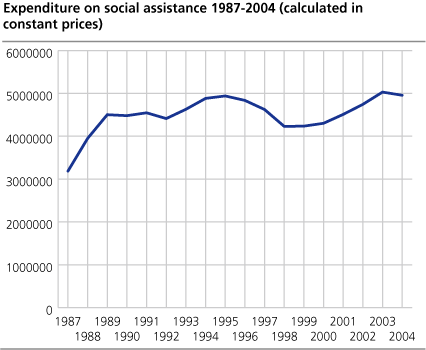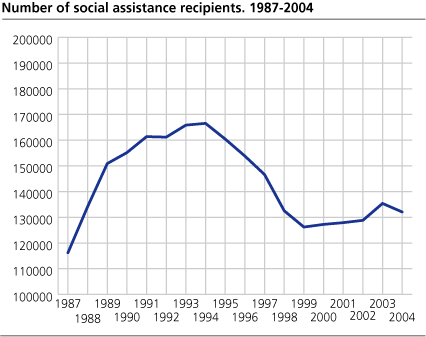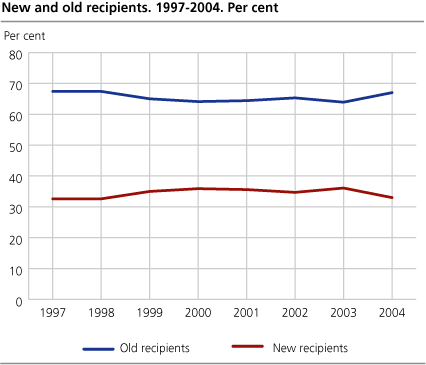Content
Published:
This is an archived release.
Stable proportion of social assistance recipients
The proportion of the population who receive social assistance remained stable from 2003 to 2004. The same applies to the average period of assistance.
The act relating to benefits to recently arrived refugees and immigrants was introduced as a voluntary arrangement for the local authorities on 1 September 2003, and as a compulsory arrangement on 1 September 2004. As the benefit was introduced late in the year, the figures for 2003 and 2004 are not fully comparable with each other or previous years.
The main picture is stable
The 132 100 social assistance recipients in 2004 received NOK 4.9 billion in total, or almost NOK 7 100 per person per month. The average payment per person per year was NOK 37 200 and the average recipient was on benefit for five months - approximately the same level as in 2003
Although the number of social assistance recipients fell last year, their share of the population was approximately the same as in the last five years, at 3 per cent. Many recipients of social assistance have children and a spouse. If we include these, approximately 218 000 people received social assistance for a shorter or longer period in 2004.
The age pattern among social assistance recipients has not changed much in the past years, and the largest group of recipients is aged 30-39 years. However, the largest group as a proportion of the population is the 20-24 age group.
Social services staff
At year-end 2004, there were 5 395 job positions in the social services. This only includes positions related to traditional social services tasks such as counselling, consultations, preventive work and work related to substance abusers. If we include positions related to job creation programmes, the figure increases to 6 084. There are still large differences between counties, but the average ratio of employees per 1 000 adults (aged 18 and above) was 1.7 full-time equivalents per 1 000 adults in 2004.
Tables:
- Table 1 Number of cases on social assistance, by age, county and size of municipality. 1987-2004
- Table 2 Expenditure on social assistance, by nature of assistance, county and size of municipality. 1987-2004. 2004-kroner
- Table 3 Average payments of social assistance per month on assistance. Figures of duration of benefit and family cycle phase. 2004
- Table 4 Recipients of social assistance, by duration of benefit and family cycle phase. 2004
- Table 5 Recipients of social assistance, by number of municipalities from which they have received payments and age. 2004
- Table 6 Recipients of social assistance, by main source of income and family cycle phase. 2004 (Corrected 02.03.2006)
- Table 7 Recipients of social assistance, by labour force status and family cycle phase. 2004 (Corrected 28.02.2006)
- Table 8 Recipients of social assistance, by type of allowance and family cycle phase. 2004
- Table 9 Recipients of social assistance, by country background and age. 2004
- Table 10 Man-years in social services per 31 December, by county. 2004 (Corrected 16 August 2006)
Contact
-
Unni Beate Grebstad
E-mail: unni.grebstad@ssb.no
tel.: (+47) 94 50 68 66



